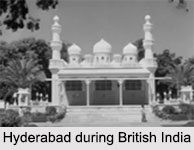 The Nizam`s Contingent or Nizam`s Army became the Hyderabad Contingent following the treaty of 1853. This contingent was divided into regiments or military units. One such unit was Infantry. Given below are the Infantries of the Hyderabad Contingent.
The Nizam`s Contingent or Nizam`s Army became the Hyderabad Contingent following the treaty of 1853. This contingent was divided into regiments or military units. One such unit was Infantry. Given below are the Infantries of the Hyderabad Contingent.
1st Infantry, Hyderabad Contingent
1st Infantry, Hyderabad Contingent was raised as the 1st Battalion of Sir Henry Russell`s Brigade in 1813. In 1826, it became 1st Regiment of Infantry, Nizam`s Army. In 1854, it turned into 1st Infantry, Hyderabad Contingent. After turning into became the 94th Russell`s Infantry in 1903. After turning into 1st (Russell`s) Battalion 19th Hyderabad Regiment and the Kumaon Regiment, the unit was allocated to India on Partition in 1947.
2nd Infantry, Hyderabad Contingent
2nd Infantry, Hyderabad Contingent was raised as the 2nd Battalion of Sir Henry Russell`s Brigade in 1813. In 1826, it became 2nd Regiment of Infantry, Nizam`s Army. It was in 1854 that the unit came to be known as 2nd Infantry, Hyderabad Contingent. After turning into 95th Russell`s Infantry, 10th (Training) Battalion 19th Hyderabad Regiment and the Kumaon Regiment, the unit was allocated to India on Partition in 1947.
3rd Infantry, Hyderabad Contingent
3rd Infantry, Hyderabad Contingent was raised as 2nd Battalion of the Aurangabad Division in 1797. It then started being identified as the 3rd Regiment of Infantry, Nizam`s Army in 1826. It turned into the 3rd Infantry, Hyderabad Contingent in 1854. Later after being identified as the 96th Berar Infantry, 2nd (Berar) Battalion 19th Hyderabad Regiment and the Kumaon Regiment, the unit was allocated to India on Partition in 1947.
4th Infantry, Hyderabad Contingent
4th Infantry, Hyderabad Contingent was raised as the 3rd Battalion of the Aurangabad Division in 1794. In 1826, it became the 4th Regiment of Infantry, Nizam`s Army. The unit turned into 4th Infantry, Hyderabad Contingent in 1854. After turning into 97th Deccan Infantry, 3rd (Deccan) Battalion 19th Hyderabad Regiment and the Kumaon Regiment, the unit was allocated to India on Partition in 1947.
5th Infantry, Hyderabad Contingent
5th Infantry, Hyderabad Contingent was raised as the 1st Battalion of the Ellichpur Brigade in 1788. In 1826, it became 7th Regiment of Infantry, Nizam`s Army and was transformed into 5th Infantry, Hyderabad Contingent in 1854. The unit was allocated to India on Partition in 1947.
6th Infantry, Hyderabad Contingent
6th Infantry, Hyderabad Contingent was raised as the 2nd Battalion of the Ellichpur Brigade in 1788. It was transformed into 8th Regiment of Infantry, Nizam`s Army in 1826 and became the 6th Infantry, Hyderabad Contingent in1854. The unit was allocated to India on Partition in 1947.



















